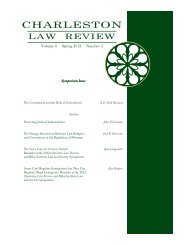Volume 5 Winter 2011 Number 2 - Charleston Law Review
Volume 5 Winter 2011 Number 2 - Charleston Law Review
Volume 5 Winter 2011 Number 2 - Charleston Law Review
Create successful ePaper yourself
Turn your PDF publications into a flip-book with our unique Google optimized e-Paper software.
CHARLESTON LAW REVIEW [<strong>Volume</strong> 5lodestar standards. 87Therefore, if flat fees can be manipulated, they are stillsubject to the economic principles of moral hazard andasymmetric information, and if their reasonableness is to bedetermined by the same standards as those used for billablehours, then what is the advantage to the client, if any, in a flatfee arrangement?In a word, predictability. Yes, many of the same client risksapply to a flat fee as to a billable hour arrangement, but thesignificant difference is that a flat fee quoted up front, gives theclient the ability to shop around and compare the fee to whatother attorneys would charge for the same work. Achievingpredictability over legal costs and shifting some of the risks ofinefficiency from the client to the lawyer can be quite popularwith clients. 88It is beyond the scope of this article to detail all thecomplexities of flat fee arrangements, but one clear issue is thatboth client and lawyer must have an understanding of the workto be done and acknowledge that law can be complicated andvariables in a particular case may be hard to foresee. Still, thoseproblems tend to run to the lawyer more than to the client, asopposed to the billable hour situation where the deck is stackedin favor of the lawyer. This writer has no doubt that lawyers inflat fee arrangements will prove to be more efficient and bettertime managers than those billing by the hour.The hourly billing arrangement still prevails in today’s legalprofession, but it has been met with increasing resistance fromclients. Instances of lawyers committing outright fraud in theirhourly billing practices, while hard to quantify, have receivedcoverage in the news media when exposed, which has donenothing to improve the image of lawyers. 89 While the hourly feemay seem like it has been around forever, it has been theprevalent method of billing only since the 1960s, and its87. Douglas R. Richmond, Understanding Retainers and Flat Fees, 34 J.LEGAL PROF. 113, 134 (2009).88. Charles S. McCowan, Jr. & Esteban Herrera, Jr., Alternative FeeArrangements: Time for Consideration, 43 LA.B.J. 466, 467 (1996).89. See Purdum, supra note 70.190







